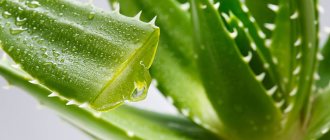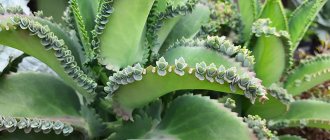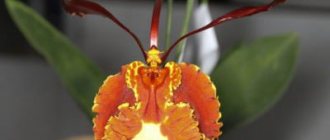- August 12, 2019
- Houseplants
- Daniil Belousov
Aloe is an ornamental plant that is distinguished by very fleshy and thick leaves. It is widespread in African countries. However, everyone knows it under the name agave, since it grows in almost every home. Many people are familiar with the amazing healing properties of this plant. But like any other, it needs proper nutrition, lighting and watering. Therefore, let's look at the features of aloe vera. How to care for this unique plant at home?
Lighting
It is immediately worth noting that this plant is very demanding of light. Therefore, it is best to place it on the sunny side. This is especially true for the cold season. During this period, you need to periodically move the aloe to the most illuminated points of the apartment. If there is not enough sunlight in the room, then in this case the plant will have to be illuminated using artificial lighting.
During the hot season, it is recommended to place aloe on the balcony, or even directly outside. In this case, the plant will happily enjoy direct sunlight. This is one of those plants that is not afraid of sunlight. Since its leaves are filled with a jelly-like mass, the sun’s rays cannot damage the hard peel.
How to grow aloe from a leaf
This method of growing an aloe vera seedling or other type of crop at home is more labor-intensive.
Chinese date - how to plant and care for it correctly
For rooting, it is necessary to use the lower leaves from a plant older than 3 years. They must be fully developed and have good turgor. The leaves need to be cut off at the base with a sharp knife and placed in a shaded, dry place to form a protective film for 2-3 days.
Rooting should be carried out in clean sand, which should be calcined in the oven in advance. For planting, you need to choose wide bowls with drainage holes to drain excess water. It is necessary to fill them with prepared sand and moisten it evenly. The leaves need to be buried 3 cm in the sand, and the container with seedlings should be placed in a warm, bright place with an air temperature of 23-25 °C.
Important! To grow aloe from a leaf, as well as from a shoot, it is not necessary to create a greenhouse effect during rooting, as this leads to rotting.
If all recommendations are followed, after 1.5-2 months small sprouts should appear at the base of the leaves. Throughout this period, the sand in the container must be kept slightly moist.
Leaf propagation requires patience
It is necessary to plant young seedlings in separate containers when their leaves grow to 3-5 cm. In this case, you need to take a full-fledged substrate as for adult plants.
Knowing how to grow aloe from a leaf, you can get a large amount of planting material. This propagation method allows you to preserve all the specific qualities of the mother plant, which cannot be achieved if you germinate seedlings from seeds.
Watering
If we talk about how to care for aloe, the description in any specialized literature will contain information that you do not need to “water” this amazing plant abundantly and often. Moreover, it is better not to water the aloe once again than to add too much moisture to the soil.
In the cold season, the flower is moistened as needed when the soil dries out. Moreover, for watering it is recommended to use dispersive sprinklers. When the warm season begins, aloe is watered every day. However, the procedure is performed exclusively through the pallet. That is, water is not poured directly to the roots, but only into the pot stand. It is also worth paying attention to the fact that it is recommended to first pour water into the tray and then wait 20-30 minutes. If there is anything left in it, the liquid is drained. In this case, you can avoid the fact that the soil will take more moisture than it needs.
Features of care
Landing
The question of how to plant aloe from a shoot is of interest to novice gardeners. For aloe, pots are purchased before planting. They should be spacious and large in volume, preferably ceramic, so that the root system can “breathe”. The root grows well, it will be uncomfortable in a small bowl, since an incorrectly planted aloe shoot begins to signal an error with crawling roots and drying leaves.
Replanting should be done when the plant becomes crowded. Each time the aloe flower is placed in a new, larger (in accordance with the dimensions of the flower) bowl, in a certain soil composition. Although the unpretentious plant does not require soil, for a young sprout you need to buy soil at a flower shop. By the way, agave prefer to grow in cacti soil.
First, drainage is poured, then soil. Lightly shed and you can plant aloe. After planting, the indoor flower is placed in a cool place where direct sunlight does not reach. Then they transfer it to a sunny windowsill: after all, agave (the second name for aloe) is a heat-loving plant.
ADVICE
Experienced gardeners advise keeping the soil in a hot oven to protect the future plant from diseases and harmful insects.
Watering rules
With proper care, aloe grows quickly at home. When watering aloe, you must follow this rule:
- In summer, once every 7 days is enough, but generously. If the agave begins to bloom, watering increases.
- In winter, when the plant rests, it grows very slowly, moisture consumption is minimal, it is enough to water once every 15 days.
How to water aloe properly so as not to harm it:
- Moisture stagnation should not be allowed. Roots rot in water. A lack of moisture in the soil is easily determined: usually the fleshy leaves become flat and the tops curl.
- A drainage cushion made of expanded clay, brick chips, and fine gravel helps prevent stagnation.
- Before planting aloe, the bottom of the pot is drilled in several places so that excess water drains into the tray, otherwise the ground becomes covered with a green coating.
- Watering from above is prohibited. It is better to pour water into a tray and place a flower in it.
- Use water at room temperature. If water is taken from the system, it is first settled.
- In summer, high humidity is created around the plant by spraying
- Once every two months, special fertilizers are added to the water for irrigation and the home healer is fed.
Lighting Features
We've talked about how to water aloe, now it's time to talk about lighting. Any home flower is demanding of a certain light regime. Place the agave on a sunny windowsill. As for the winter period, it can withstand darkening well, dispensing with artificial lighting.
To create a uniform arrangement of leaves, indoor flowers, including agave, are moved to the balcony for the summer. You need to place it so that direct sunlight does not hit it and burn it.
Properly caring for agave means creating temperature conditions: in summer from +22 to 26 degrees, in winter within +10 and a little higher.
Transfer rules
The indoor flower needs to be replanted. This procedure is usually carried out with the onset of spring days. If you transplant the agave correctly, it quickly takes root and begins to form new leaves.
Before replanting aloe at home, divide the plants by age. If the plant is young, it needs to change the pot and soil annually. Old after 2 or 3 years. It is also necessary to plant heavily overgrown agave plants, regardless of age.
After preparing the container and soil, separate the plant from the pot using a knife. You need to shake off the old soil from the roots and cut off the darkened roots. The same operation is carried out with damaged roots. Having placed the flower in the center, you need to add soil and compact it.
When aloe is transplanted, a lot of varied planting material remains:
- root shoots;
- accidentally broken leaves;
- cut cuttings from the top. By the way, the top is specially cut off to obtain a new plant.
Which aloe breeding method should you choose?
There are several ways to propagate aloe, each requiring its own approach. Therefore, if you have no experience, you will have to decide and choose one thing:
- Seeds. Not all flower growers decide to use this method, because it takes a whole year to get a flower. It looks like this: sowing seeds, obtaining seedlings, caring for them, creating certain conditions. You'll have to fiddle around like a small child.
- Growing aloe from a leaf is a practical method. Pinch off the planting material and sprinkle the cut with activated carbon. Let it sit for 5 days to dry. Then immerse it 5 cm into the ground and cover it with a jar. Since the leaf is without a root, planting is carried out in moist soil and covered with a jar on top. The created greenhouse effect accelerates the development of the root system (10-15 days).
- Now let's figure out how to grow aloe from a shoot. Take the desired part from a healthy plant. The shoot should have up to 8 leaves. Trim the aloe in the right place and remove the planting material to dry for five days. Before planting an aloe shoot, you need to make sure that the lower leaves reach the moist soil. The shoot takes root well on a lighted windowsill. The first signs that the plant has taken root will appear in about a month.
- Agave plants are propagated by children. This is the name given to shoots coming from the root. If aloe babies are without roots, they can also be used as planting material. The root system will then develop.
Content temperature
How to care for aloe? If we talk about temperature conditions, it is best to install the flower on a window on the south or east side. In this case, the plant will not be able to freeze and at the same time receive the greatest amount of light. When it gets cold, be sure to place the pot on the warmest window. Care must be taken to ensure that the temperature does not drop too low. Otherwise, the aloe will stop blooming and developing. Since this plant originated in Africa, this means that it is dependent on sunlight, and therefore on heat. Nevertheless, home room temperature is quite enough for this flower.
If we talk about the minimum permissible temperature in the room, then for aloe in a pot it is +15 degrees. It is undesirable for it to go lower. If the plant begins to freeze, the foliage will become more lethargic and lifeless.
If it is a cold winter, then in this case it is recommended first of all to insulate the windows on which the flowers are located, and also to ensure that there are no drafts. You can put a sheet of polystyrene foam or other warm material on the windowsill, which will create an elevation and prevent the pot from coming into contact with the cold window sill. This will prevent hypothermia through the so-called bottom ball of soil. If the plant gets too cold, the roots may begin to rot. It is very difficult for an agave to recover from this.
Aloe propagation methods
There are several options for propagating this succulent. We choose a way to propagate aloe at home, for example:
- Radical shoots.
- Plant cuttings.
- Seeds.
- Upper shoots.
Reproduction by root shoots coincides with the planned transplantation of an adult plant. Using a sharp knife, you need to separate the shoot (it is also called “baby”) and place it in a glass of water for the roots to grow. It should take about two to four weeks for the shoot to take root. So, it's time to transplant it into a pot. Then all that remains is to follow the rules on how to grow aloe at home.
Propagation by cuttings involves using a very sharp knife to cut a leaf from an adult plant that has at least eight large leaves. The cut area should dry out a little. Treat the cut with ground activated carbon. This leaf needs to be stored outdoors for about a week. After the cutting site has completely dried, the cuttings can be planted in the ground. If there are a lot of cuttings, then they are planted in rows. Aloe cuttings can be carried out throughout the year.
Propagation by seeds is carried out in early spring, around March-April. You should first prepare small dishes and soil. The room temperature should be more than +20 °C. Water the soil in the container and spread out the seeds, cover it with a thin layer of sand, and cover the container with glass or film. It is necessary to provide watering and spray the emerging leaves in a timely manner. As soon as three true leaves appear, the seedlings need to be transplanted into other containers no more than five centimeters high. After a year, the grown plants are transplanted into larger containers. This is not the easiest method of propagation, but a large number of plants can be grown.
Reproduction by upper shoots occurs in the same way as by basal shoots. After cutting off the top with a sharp knife, the plant is dried for about three days. Then they are planted in wet sand to a depth of three to four centimeters. After rooting, they are transplanted into another container, and then they begin to grow aloe at home like any indoor plant, with love and care.
What kind of soil is needed
Aloe requires careful care in this regard. This also includes preparing the right soil. In this case, most experts recommend giving preference to slightly acidic soil compositions. This ideal soil for aloe consists of turf and leaf soil, humus and coarse river sand. Also, do not forget about drainage. In this case, you can use ordinary broken stones. And if a transplant is carried out, then before this procedure it is necessary to clean the aloe roots from the old soil and treat them with charcoal.
Aloe: how to care and replant?
If we talk about the dimensions of the pot for replanting, they are determined based on the size of the root part of the plant. Therefore, before performing any transplantation manipulations, it is necessary to determine the width and length of the root system. The pot is selected in such a way that the roots can fit freely in the container. It should be taken into account that the agave develops quite quickly, and accordingly, the root system begins to grow. But this does not mean that you need to immediately plant the plant in a huge pot. It is best to perform the transplant procedure more often. Then the aloe will feel better, and the soil will not oxidize.
Top dressing
When considering how to care for aloe, you should not miss this important stage. Like any other plant that is in the room, the agave also needs to be fed periodically. It is important to consider that only healthy plants are fertilized. If aloe is sick, then first of all it needs to be cured. After replanting a damaged flower, it is recommended to fertilize it no earlier than after 3 months.
It is also worth paying attention to the fact that any fertilizers are applied only after watering. It is recommended to feed the plant exactly when it is actively growing. In order to decide how to care for aloe, the description of the plant should be studied in detail and the optimal feeding for the agave should be selected. For example, experienced flower growers recommend the preparations “Power of Life”, “Agricola” and “Bona Forte”.
It is also recommended to apply fertilizers through a tray. In this case, you can protect the plant from the possible aggressive effects of some components.
How to care for a flower in open ground?
It turns out that aloe vera can be grown not only at home, but also outside . To plant it you need:
- Clear the prepared area of weeds and blades of grass.
- Fill the hole with a nutrient mixture obtained from the following components:
- turf land;
deciduous soil;
- coarse sand;
- humus.
- Before planting, the roots must be dried for 3 days, and then the plant must be lowered into the prepared substrate.
- To prevent overgrowing of weeds, you need to surround the flower with stones.
Everything needs to be mixed in a ratio of 2:1:1:1.
It is worth fertilizing an outdoor plant with organic compounds that are used for home aloe vera.
How to prepare for winter?
It is especially necessary to protect the plant from low temperatures in regions with snowless winters, since then the risk of aloe vera freezing increases. The following natural materials are suitable for shelter:
- needles;
- spruce branches;
- high peat;
- sawdust;
- fallen leaves.
Plants need to be covered at the end of October.
What to do in winter?
In winter, you need to take special care of the plant. And although aloe vera is dormant, physiological processes still occur in it, and their implementation requires adequate lighting and proper hydration.
- In the morning and evening, you need to turn on the lamps, since the duration of daylight should be at least 15 hours.
- Watering in winter should be done early in the morning. It is better not to water from a watering can, otherwise the water will wash away the surface layer and will not moisten the main root. It is best to pour the liquid into the tray in which the pot stands, and from there it will gradually rise up through the soil capillaries. This moistening will take 30 minutes: if at a depth of 3-5 cm the soil becomes wet during this period, then the water can be poured out of the pan.
Problems during this period: why does it dry out?
Dry rot often affects aloe vera in winter. It occurs as a result of irregular watering or frequent fluctuations in humidity and temperature. It is easy to recognize this disease - the plant begins to dry out greatly. It is no longer possible to cure a flower from dry rot, but as a preventative measure it is worth installing an air humidifier in the room. Even with improper watering in winter, the roots can rot, so for prevention you need to use moderate moisture.
Aloe vera is an amazing plant that is incredibly beneficial for the human body. It is used not only in medicine, but also in cosmetology. By following all the rules for caring for flowers, growing it at home will not be difficult even for an inexperienced gardener, and the plant will generously reward you with bright and lush flowering.
Root pruning
This procedure is usually performed during the process of transplanting or planting a fairly mature aloe. In this case, the roots of the plant are pruned. This manipulation is performed to ensure that the plant grows at a faster rate in the new soil. Foliage pruning is also carried out. Thanks to such manipulations, it is possible to control how widely aloe will grow. For example, if you want the flower to grow upward or not rest against the walls of the pot, then in this case the leaves and shoots located on the sides are removed.
Reproduction
This is another important step in how to care for indoor aloe. As a rule, such procedures are performed simultaneously with plant transplantation. The easiest way to get a new flower is from an aloe leaf. To do this, during the replanting process, you need to cut off several mature leaves, on which fairly hard thorns have already formed. After this, they are left for some time to dry. At the next stage, the leaf plates are planted directly into the ground. The land also needs to be prepared.
In this case, it is necessary to mix leaf soil, sand and slightly moisten the soil. After this, the future sprout in the pot should be placed in a fairly bright place, where the temperature is 15-18 degrees Celsius. It is worth being patient, as the first root of a young seedling does not appear quickly. This does not mean that you need to start being diligent and watering the plant every day. This is completely normal, so just wait a little longer.
If you take good care of such a young plant, feed it and monitor its health, then within three to four years flowers will begin to appear on it. Aloe vera (how to care for it is described in the article) is really capable of blooming. Few people know about this. However, aloe pampers with its beautiful inflorescences only those gardeners who are the luckiest.
How to replant aloe at home
Aloe should be replanted, like all flowers, in the spring. True, it is worth considering the age of the plant. Young succulents need an annual change of substrate, older ones every two years.
Important: when transporting a flower from one container to another, you should very carefully shake off the old soil so as not to damage the roots.
How to plant without roots
During a standard plant transplant, there is often a lot of excess planting material left, represented by leaves. You can also root them by first treating the base with coal and then placing them in moist soil.
Humidity
If we talk about caring for aloe, then you should pay attention to this important indicator. It must be taken into account that overly moist soil is not suitable for agave. At the same time, the air in the room should not be very dry. Therefore, if it is not possible to install a pot of aloe in the room in which the air is humidified, then at least once a week it is necessary to spray the plant trunk with water using a sprayer. It is also recommended to humidify the space next to it.
Medicinal properties and uses
Benefits and contraindications
Aloe vera is widely used for medicinal purposes.
Internal use of Aloe Vera juice:
- The juice made from the leaves of this plant serves as a good laxative;
- Created medicinal preparations containing squeezed aloe vera juice are effective in the fight against gastritis;
- Also, the squeezed juice of this plant helps reduce stomach acidity;
- Helps against chronic colitis;
- Aloe vera syrup with added iron is effective in treating anemia;
- Used for migraines;
- Helps with neurosis;
- Highly effective in the fight against ulcers and bronchial asthma.
External use of juice:
- Helps with the formation of purulent wounds;
- Eliminates streptococci;
- Fights E. coli;
- This juice is effective in the fight against diphtheria bacillus;
- Promotes rapid healing of wounds;
- The leaves are often used to relieve sunburn.
Aloe vera is widely used in medicine to combat various diseases. The plant is officially included in the list of pharmaceutical drugs.
Despite the large number of useful components, Aloe Vera also has contraindications . Thus, preparations based on aloe vera are contraindicated for people with the following diseases:
- Gallbladder diseases;
- Liver disease;
- For cystitis;
- Haemorrhoids;
- Pregnancy and lactation.
Aloe Vera can be used for children only after consulting a doctor!
Also read: Choosing succulents for planting in the ground in the garden
Recipes
To prepare the juice, you will need to cut off the lower or middle leaves of a healthy plant. After which they need to be washed well, dried and placed in the refrigerator for 7 days. After this time, you can prepare to squeeze the juice.
There are many different recipes using Aloe B. The article discusses the most popular recipes using this plant.
- Recipe for using aloe vera to improve digestion and after suffering a serious illness:
Required:
-Aloe juice-150 grams
-Honey-250 grams
-Strong red wine-350 grams
All ingredients are mixed and left for five days. The prepared mixture must be consumed three times a day, after meals.
- Recipe for an exhausted body :
Required to mix:
-Half a glass of aloe juice
-Crushed walnuts - 500 grams
-Honey-300 grams
-Sourced lemon juice. You need to use 3-4 lemons.
It is required to consume the resulting mixture three times a day before meals.
- Against cough:
– 30 gr. Aloe V. juice
– 30 gr. lingonberry juice
– 10 gr. liquid honey
Mix everything, take 2 tablespoons 4 times a day.
Aloe vera for face
This type of succulent is very popular in the field of cosmetology. Cosmetics containing this plant are recommended for owners of sensitive skin prone to various allergic reactions. Numerous creams and masks containing Aloe V. help in the fight against age spots, provide protection from the effects of environmental factors, and enrich the skin with nutrients.
It is noted that the use of masks and creams based on aloe vera has a great effect on the skin. Aloe vera is most valued in the fight against psoriasis, purulent discharge and the appearance of acne.
You can apply freshly squeezed juice daily to your skin, or add a couple of drops to your face cream.
Mask to maintain youthful skin:
– 2 tbsp. spoons of Aloe V. juice
– 2 tbsp. spoons of liquid honey
Mix and apply to cleansed skin once a week for 20-30 minutes. Can be stored in the refrigerator.
Aloe vera for hair
The plant has a beneficial effect on the scalp and hair roots. Aloe V. is widely used to eliminate the following pathologies:
- Copes with dandruff
- Helps with hair loss
- Helps with baldness
- Has healing properties for split ends
Advantages:
- Adds volume to hair
- Creates thick hair structure
- Adds shine to hair
- Gives strength to hair roots
Aloe vera juice is used to treat hair. The juice is rubbed into the scalp daily. After a positive result, the procedures can be applied 1-2 times during the week.
Aloe vera is a unique plant that is widely used in medicine and cosmetology. This plant, rich in nutrients, is also loved by flower growers all over the world and is used everywhere. Aloe vera is one of the most popular plants living in homes; it looks great in the interior and is easy to care for.
Diseases and pests
Very often, gardeners grow several types of aloe together under similar conditions. This mixture of seeds for growing together is called aloe mix. Home care is not much different between species when it comes to insects and diseases. They suffer equally from pests, just like any other plants.
Even despite its vitality, aloe can develop root rot. To exclude the possibility of this disease, you need to carefully examine the plant. If it has at least a few leaves that are much darker and look limp, then in this case you need to remove the agave from the pot as quickly as possible and inspect the roots. It is quite possible that they have begun to rot. This can happen if you water the plant too often or too much. After assessing the root system, you need to cut off all damaged roots and transfer it to new soil. If no healthy roots are found at all, then in this case you need to remove all the diseased roots and re-root.
When considering how to care for aloe, you should be prepared for the fact that the plant may suffer from dry rot. In this case, we are talking about drying out of the root system. The same will be visible on the leaves. As a rule, in such situations it is almost impossible to save aloe, since this unpleasant condition progresses too quickly.
Aloe can also harbor scale insects. This is a fairly common pest that likes to settle on the back of leaves. If you lift the leaf, small wax shields no more than 2 mm long will be visible on it. The worst thing is that these pests form large colonies that are located on plant stems. You can also pay attention to the leaves. If red-brown spots appear on them, this indicates that the damaged areas will soon die. It is noteworthy that it is very difficult to get rid of this pest if it proliferates greatly. Therefore, it is worth periodically inspecting plants for the presence of such insects. If you suspect this pest, it is recommended to wipe the plant daily with a cotton cloth soaked in vinegar. Chemical insecticidal preparations for scale insects - “Fitoverm” and “Aktara”.
Problems
During its development, aloe can be susceptible to a number of diseases that should be recognized at an early stage in order to be able to keep this succulent healthy.
The leaves are turning yellow
There may be several reasons why leaves begin to turn yellow. Depending on the location of the spots on the surface of the sprout, the prerequisites for the occurrence of the disease vary.
- If the color changes at the tips of the leaves, it is worth inspecting the plant for pests. If you couldn’t find any, then perhaps you either chose the wrong soil or flooded the flower, as a result of which its roots began to rot. To eliminate the problem, it is necessary to normalize the lighting, regulate the flow of moisture and carry out insect prevention.
- Another problem associated with excessive moisture in the substrate is yellowness at the base. In this case, only normalizing the irrigation system will help.
- But if the entire leaf is covered with yellow spots, the problem is exactly the opposite - the plant is catastrophically short of water. To rid aloe of the disease, simply water it using a moderate amount of moisture and systematically wipe the greens with a damp rag to remove dust (to prevent pests, add a little medical alcohol to the liquid).
The leaves are curling
If the soil mixture is selected incorrectly, the plant's leaves may begin to curl. This is due to the excessive content of organic substances in the soil, as well as the presence of microbes. The only solution to the problem is to transplant the flower into new soil.
The roots are rotting
It is possible to save a flower if its roots have begun to rot only if the disease is detected in the early stages. This situation arises due to too much watering of the plant (it is optimal to irrigate the succulent a couple of times a month or when the soil is sufficiently dry).
You can help aloe only if the roots have not rotted completely, but only partially. To do this, it is necessary to immediately transplant the flower into a new pot and replace the soil.
Important: it is recommended to dispose of the container in which the diseased plant was located, because the fungus remains on its walls for a very long time.
Doesn't grow
If no visible reasons for the aloe disease could be found, but the plant has slowed down its growth, there is a possibility that it simply froze. You can fix the problem by moving the pot to a more illuminated and warmer place, not forgetting to check if it is blowing from the window.
The leaves are falling
For the same reason as stunted growth, massive leaf loss of agave may occur. In this case, you should pay attention to the temperature of the water for irrigation - cold water has a detrimental effect.
Redness on the leaves
The appearance of redness on the surface of leaf blades can be not only a manifestation of insect activity (spider mites), but also a reaction to sunlight - succulents tend to “sunbathe”.
Brown spots
Darkening of sheets with brown tints can indicate several problems:
- Lack of moisture in the soil.
- Severe contamination (the color becomes almost black).
- Infection with fungal diseases (the plates are covered with a soft coating).
Dry rot
Another type of rot that aloe is susceptible to. However, in this case, it is unlikely that it will be possible to save your favorite plant, because the process occurs directly inside the succulent. The only thing that remains for flower growers in this case is to try to prevent the occurrence of the disease through regular prevention using fungicides.
No matter how unpretentious aloe vera is, the growth and health of this flower are directly related to timely and proper care. Therefore, try to pay attention to your green “pet” as often as possible in order to identify and eliminate problems in time. Then the plant will delight you and bring benefits for many years.
Other pests
Even with good care, aloe at home can suffer from mealybugs. This is one of the largest and most visible pests. As a rule, it is removed from the plant mechanically. To do this, just use a brush and tweezers. After removing all the scale insects, it is necessary to treat the affected areas of the plant with garlic broth (half a liter of water is brought to a boil, 4-5 cloves of garlic are added, and left to cool). During this period, it is recommended not to expose the plant to direct sunlight. It's better to move it to the shade. In the most severe situations, an insecticide can be used.
Aloe can also be periodically attacked by spider mites. These are very small pests that are almost impossible to notice. They do not like cold water, so in the summer you can spray the agave with a very cold solution of soapy water or tobacco. Spider mites simply cannot tolerate these components. Garlic broth also shows high effectiveness. If all else fails, you can use chemicals.
Aloe Vera Flowering
It is generally accepted that aloe vera does not bloom. However, the plant can bloom, but more often in natural conditions. At home, it rarely blooms, since it is quite difficult to create special conditions for flowering.
The flowering period of aloe is a long process. As a rule, the peduncle appears in the area of the axils of the upper leaves of the plant. In most cases there is only one peduncle, however, rare cases of flowering of several peduncles at once have been observed. The flowers that appear are cylindrical, bell-shaped, yellow-pink in color, and have long pedicels. Aloe vera usually blooms in winter.
Photo: Aloe Vera blooming











